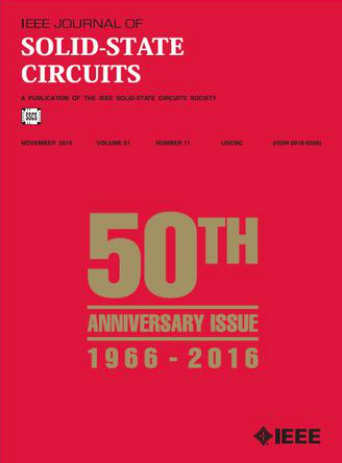基于静电力反馈控制的430 μA 68.2 db - snr 133- dbspll - aop CMOS-MEMS数字传声器
IF 4.6
1区 工程技术
Q1 ENGINEERING, ELECTRICAL & ELECTRONIC
引用次数: 0
摘要
介绍了一种基于静电力反馈控制(EFFC)的高声动态范围、低功耗数字传声器。该设计通过在不同输入幅值下自适应偏置来调节微机电系统(MEMS)的灵敏度,从而扩展动态范围(DR)。提出的自适应偏置技术允许感应静电力作为模拟前端(AFE)之前的机械增益,从而放松读出电子器件的噪声性能要求。采用一种增益可调的电容反馈仪表放大器(CFB),有效地降低了传统阻性反馈仪表放大器(RFB)中由反馈电阻引入的热噪声。为了实现高效的声体积检测,提出了一种由级联低阶抽取滤波器组成的次采样幅度检测器(SSAD)。检测结果用于快速沉降预测参考电荷泵(PRCP)的控制。PRCP采用闭环结构实现精确的偏置电压可调,所提出的预测逻辑显著缩短了建立时间。该系统在94 dBSPL时的信噪比(SNR)为68.2 dB,声学过载点(AOP)为133 dBSPL,时钟频率为3.072 MHz时的电流消耗为430~{\mu}$ a。测得的声学DR为107.2 dB。本文章由计算机程序翻译,如有差异,请以英文原文为准。
A 430- μ A 68.2-dB-SNR 133-dBSPL-AOP CMOS-MEMS Digital Microphone Based on Electrostatic Force Feedback Control
This article introduces a high-acoustic-dynamic-range and low-power digital microphone based on the electrostatic force feedback control (EFFC). The proposed design adjusts the sensitivity of the micro-electro-mechanical system (MEMS) by adaptively biasing it at different input amplitudes, thereby extending the dynamic range (DR). The proposed adaptive biasing technique allows the induced electrostatic force to function as a mechanical gain prior to the analog front end (AFE), consequently relaxing the noise performance requirements of the readout electronics. A capacitive feedback (CFB) instrumentation amplifier (IA) with an adjustable gain is employed to effectively reduce the thermal noise introduced by the feedback resistor in conventional resistive feedback (RFB) IAs. A sub-sampling amplitude detector (SSAD) composed of cascaded low-order decimation filters is proposed to achieve efficient acoustic volume detection. The detection results are used to control a fast-settling predictive reference charge pump (PRCP). The PRCP adopts a closed-loop architecture to achieve accurate adjustable bias voltage, with the proposed prediction logic to significantly reduce the settling time. The proposed system achieves a signal-to-noise ratio (SNR) of 68.2 dB at 94 dBSPL and an acoustic overload point (AOP) of 133 dBSPL, with a current consumption of $430~{\mu }$ A at a clock frequency of 3.072 MHz. The measured acoustic DR is 107.2 dB.
求助全文
通过发布文献求助,成功后即可免费获取论文全文。
去求助
来源期刊

IEEE Journal of Solid-state Circuits
工程技术-工程:电子与电气
CiteScore
11.00
自引率
20.40%
发文量
351
审稿时长
3-6 weeks
期刊介绍:
The IEEE Journal of Solid-State Circuits publishes papers each month in the broad area of solid-state circuits with particular emphasis on transistor-level design of integrated circuits. It also provides coverage of topics such as circuits modeling, technology, systems design, layout, and testing that relate directly to IC design. Integrated circuits and VLSI are of principal interest; material related to discrete circuit design is seldom published. Experimental verification is strongly encouraged.
 求助内容:
求助内容: 应助结果提醒方式:
应助结果提醒方式:


